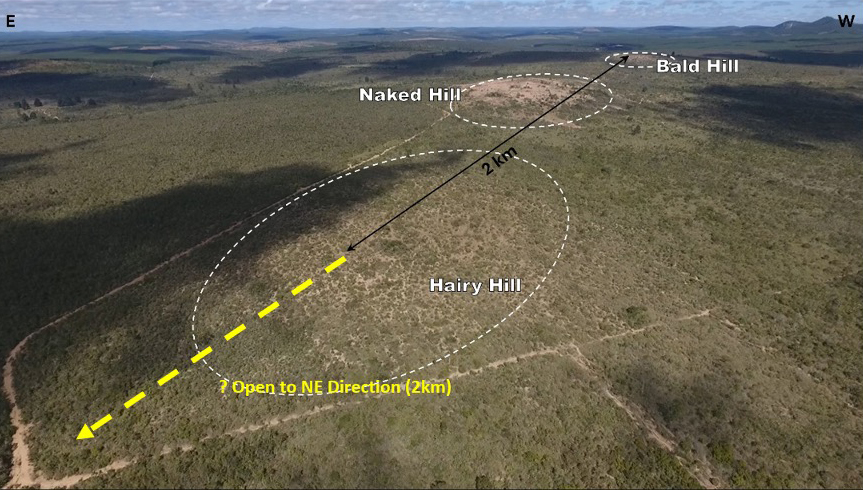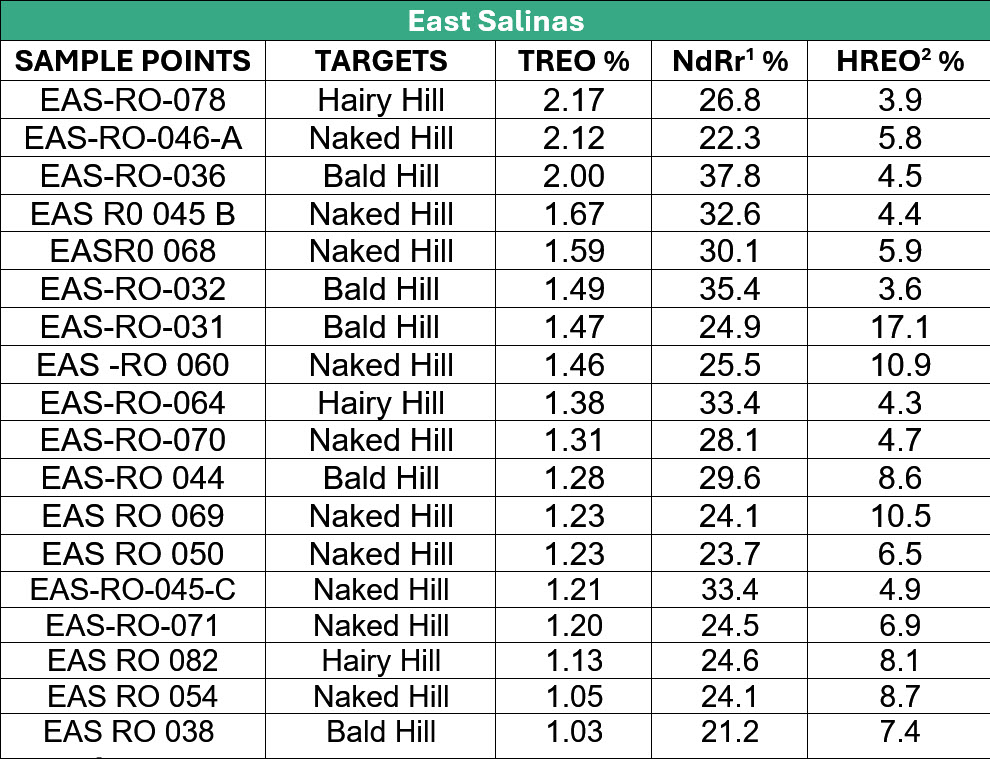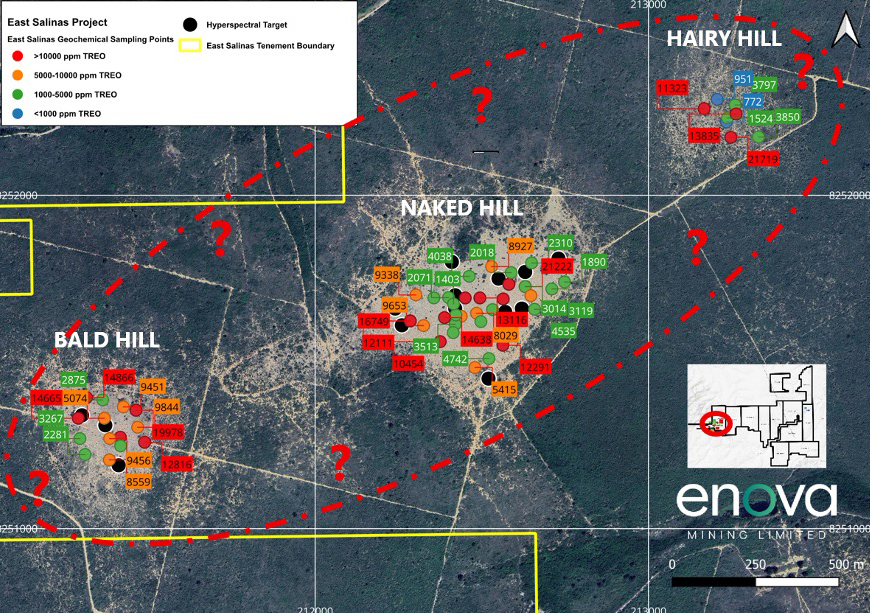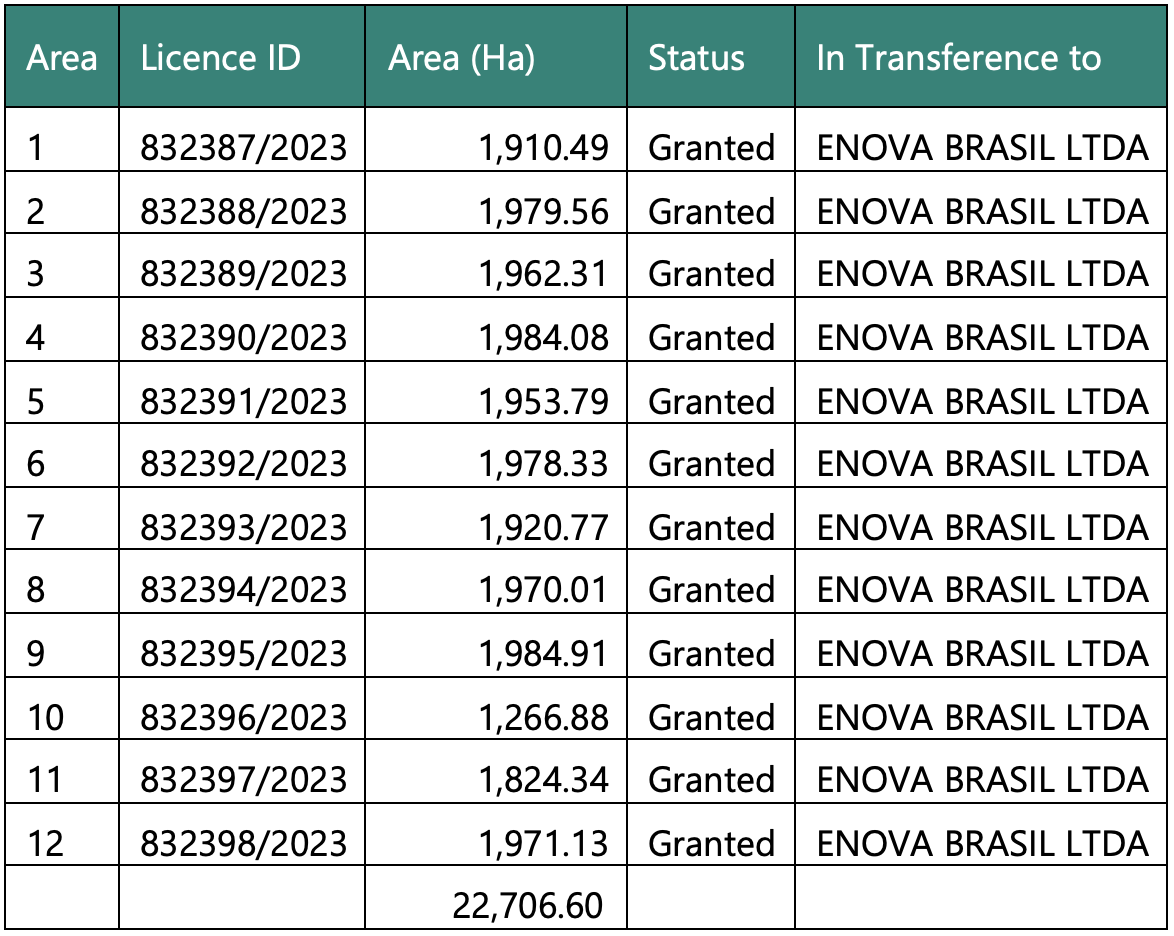Minas Gerais, Brazil
East Salinas Rare Earth Project
Next-Gen Rare Earth Discovery with Tier-One Potential
The East Salinas Project is a strategically positioned rare earth exploration play in northern Minas Gerais, Brazil, covering over 22,000 hectares within the highly prospective Medina Intrusive Granitic Complex—adjacent to Brazil’s lithium valley—and offers year-round, low-cost field operations thanks to its favorable topography and infrastructure.
Project Highlights
- Emerging High-Grade REE Opportunity
The East Salinas Granitic Complex, situated within the East Brasiliano Orogen in northern Minas Gerais, has revealed highly anomalous surface geochemical results, with Total Rare Earth Oxides (TREO) grades reaching up to 1.87%. The project also boasts exceptionally high magnetic rare earth content, with NdPr (neodymium + praseodymium) oxide ratio reaching up to 38.8%, an average Heavy Rare Earth Oxide (HREO) ratio around 9.95% and average ytterbium oxide content around 387ppm. These results strongly support the presence of REE-bearing granite and leucogranite units, confirming the potential for high-grade hard-rock REE mineralisation across the project area. - Expanding Enova’s Strategic Footprint
East Salinas complements Enova’s REE exploration portfolio alongside Juquiá, CODA North, and CODA Central. The project’s large-scale tenement coverage and its association with post-collisional granites present multiple zones of interest, including the Bald Hill and Naked Hill targets, supporting further subsurface investigations and resource delineation. - Multi-Metal Potential and Geological Richness
In addition to REEs, East Salinas shows elevated levels of neodymium and other high-value heavy rare earth elements linked with evolved granitic systems. This opens potential for valuable by-products and broader resource development across the tenement package. - Leveraging Brazilian Expertise for Efficient Advancement
Enova’s Brazilian geology team has been instrumental in advancing exploration at East Salinas through detailed mapping, systematic sampling, and field validation. Their expertise ensures efficient progression from surface sampling to future drilling and geophysical surveys. - Cost-Conscious Exploration with Strong Growth Potential
Enova is adopting a disciplined, scalable exploration strategy at East Salinas focused on high-impact outcomes. With significant upside and a large tenement footprint, the project stands out as a cost-effective and potentially transformative REE discovery within Brazil’s resource-rich landscape.
Project Potential– East Salinas Project
| Category | Potential |
|---|---|
| Mining & Exploration | - Hosted in a large (~1,150 km²) granitic batholith with district-scale potential - High-grade REE mineralisation in coarse-grained granites with visible allanite - Excellent natural exposure via sugarloaf hills for efficient surface mapping - Low-relief terrain enables low-cost, year-round exploration activities |
| Processing | - Hard rock mineralogy (potential allanite??) supports conventional beneficiation routes - Potential for scalable, modular processing infrastructure - Granitic host rock may allow selective mining and targeted recovery |
| Product | - Contains critical rare earths (e.g., Nd, Pr) essential for permanent magnets - Hard rock REE sources typically yield higher-value concentrates - Potential for co-product synergies with nearby lithium and other critical minerals |
| Environmental | - Located in pastoral, low-density area with minimal land-use conflict - Hard rock REE mineral systems generally have lower environmental risk than ionic clays - Away from Environmentally sensitive area |
Geology
The Medina Intrusive Suite within the East Salinas Project features the Granito Maristela, a vast I-type granitic batholith spanning approximately 1,150 km², characterized by coarse-grained, metaluminous porphyritic granite with prominent feldspar megacrysts and accessory minerals like allanite; it hosts diverse xenoliths near its contact with the Salinas Formation and forms striking sugarloaf hills such as Serra do Anastácio, rising sharply above the surrounding Detrito-Lateritic Cover and saprolitic terrain.
The complex reflects Brasiliano orogenic magmatism, with the Maristela granite intruding and thermally reworking older crustal rocks. Its high relief and isotropic texture contrast sharply with the flattened morphology of the metasedimentary domain
The REE results are surface signatures of potential mineralisation. Style of potential mineralisation is Rare Element enriched hard rock deposit. The mineral system is open depth and strike extension which would be established through further exploration.

Standout REE intercepts
Rock chip sampling at East Salinas has returned multiple high-grade rare earth results (Figure 1), with three samples assaying above 2% TREO. Key intercepts include:
- 2.17% TREO (21,718 ppm), 26.82% NdPr, EAS-RO-078
- 2.12% TREO (21,222 ppm), 22.32% NdPr, EAS-RO-046A
- 2.00% TREO (19,978 ppm), 37.79% NdPr, EAS-RO- 036
Additional strong results include:
- 1.59% TREO (15,946 ppm), 30.09% NdPr, EAS-RO-068
- 1.49% TREO (14,866 ppm), 35.41% NdPr, EAS-RO-032
- 1.38% TREO (13,835 ppm), 33.39% NdPr, EAS-RO-084
These assays not only confirm consistently high TREO grades but also demonstrate elevated NdPr oxide ratios of up to 37.8% and heavy rare earth oxide (HREO) contents reaching 41.3%, underscoring the strong magnetic and heavy REE potential across the East Salinas corridor
Significant rock chip results include:


Processing
Preliminary ‘sighter’ metallurgical test work is advancing at CIT Senai Laboratory in Belo Horizonte, using bulk granite rock chip samples from the project area. Building on earlier Grinding Work Index assessments, the current test phase includes mineral liberation analysis, heavy liquid separation, and heavy mineral concentrate tabling studies. These tests are aimed at establishing early stage processing pathways and assessing the amenability of the mineralisation to low-cost beneficiation and concentration techniques. Sample preparation, including grinding, is currently underway at both CIT Senai and Mineral Technologies laboratories to support upcoming metallurgical assessments.
Tenements/Permits
The East Salinas tenements are currently held by Mineração Paranaí Ltda and registered in the state of Minas Gerai. Upon completion of the permit in the official gazette, Mineração Paranaí Ltda will undertake the contractual process to transfer the title to Enova. Details of the East Salinas tenements are outlined in Table 2 and illustrated in the inset of Figure 1.


